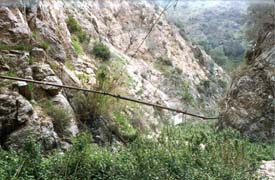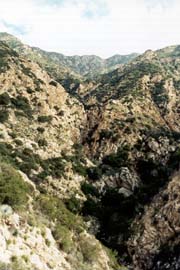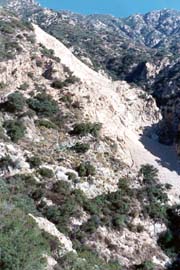Rubio Canyon has been the source of water to
locals since the time of the Indians. Before the turn of the century seven waterfalls with
names like Maidenhair Falls, Cavity Chute, Bay Arbor, Ribbon Rock, Moss Grotto, Grand
Chasm, Suspended Boulder, Roaring Rift, and Thalehaha Falls existed along with several
reflecting pools. The falls dropped thousands of gallons of water from heights ranging
from ten to nearly forty feet.
In 1892 Thaddeus Lowe built a dam in the canyon behind Echo Mountain
with the permission of the Pasadena Improvement Company; later to become Rubio Canyon Land
and Water Association. The idea Lowe formulated to power his rail car was to use the water
pressure to recharge some 300 storage batteries via three waterwheels hidden under the
floor of the Great Incline and Rubion Pavillion. Although the idea looked good on paper,
legal wrangling began when Rubio Canyon Land and Water Association’s predecessor
disagreed with the amount of water Lowe wanted to store, citing the need to service their
customers.
The Rubio Pavillion and Hotel Rubio were built at the base of the
Great Incline from late 1892 until early 1893 to serve the needs of those visiting the
area. Ten rooms, a dining hall, and a kitchen were all that were there, but the
construction workers on the Incline called it home.
By 1896 Mt. Lowe was one of the grandest tourist attractions in the
world. It was also the year of the founding of Rubio Canyon Land and Water Association,
herein after to be called RCLWA. The RCLWA was, and is, an Altadena based company whose
sole purpose is to serve the water needs of local residents. Having outlived Thaddeus
Lowe, Rubio Pavilion, and the Pacific Electric Railway, the RCLWA remains an important
part of local history, and may hold the key to preserving the history of Rubio Canyon for
future generations.
 |
This is a scene in
Historic Rubio Canyon depicting the century old water pipes used by the Rubio Land and
Water Association to bring "free" water to its many customers. It was pipes such
as these that were damaged in the 1984 Northridge earthquake prompting the company to seek
federal monies to repair said damages and subsequently creat more damage with tons of
misplaced debris.
|
Fast forward one hundred plus years and RCLWA is still filling the
washbasins and needs of its local Altadena shareholders. Periodically Rubio Canyon gets
new pipelines or repairs to insure water transport to faithful customers. Hikers from as
early as John Muir in the 1870’s to John Robinson in the 1970’s, as well as a
new breed of trail users called mountain bikers, have seen and enjoyed many parts of the
canyon’s beauty as well as the remnants of old pipes and debris left by the RCLWA,
cast aside to rust away.
Until January of 1994 when the Northridge earthquake jolted hundreds
of people’s lives, not much attention has been paid to the litter of pipes left in
Rubio Canyon. This quake and its aftershocks not only damaged homes, and buildings, but
also managed to cause breakage of water lines of the RCLWA, giving it yet another reason
to go into the canyon and replace water pipes.
The RCLWA applied for public assistance in June of 1994 after having
assessed damage to their water transport system, and has collected more than one million
dollars from FEMA (Federal Emergency Management Agency). Officials from the Office of
Emergency Services (OES), and FEMA, toured and inspected the RCLWA facilities to prepare a
damage survey report to determine the extent and cost of repairs to the waterworks. Based
on their findings the RCLWA was given this grant.
By March of 1998 RCLWA had received their grant money, and following
a meeting with shareholders on March 23rd had begun the task of dealing with
Civil Engineers which was a FEMA requirement.
Mid April of 1998 began the physical task of repair work to replace
water lines, and according to RCLWA, after several months of work, the USAD-FS, (United
States Department of Agriculture-Forest Service) became concerned about the impact of
debris in Rubio Canyon.
By Federal Fair, the national Environmental Policy Act of NEPA, to
be specific, should have been making considerations to guarantee the mutually favorable
outcome of all the parties involved. Either an environmental impact statement should have
been procured to notify all concerned parties, and/or individuals of the pending work.
Apparently the cart was allowed to precede the horse, in this case as the USDA-FS,
National Register of Historic places, Scenic Mt. Lowe Historical committee, Sierra Club,
Altadena Historical society, Altadena Land Use Committee, Altadena Town Council, and
dozens of private individuals were NEVER notified of the impending work.
 |
The upper reaches of Rubio
Canyon taken by Jake Brouwer in 1993 well before the recent events.
|
 |
The upper reaches of Rubio
Canyon submitted by Paul Ayers taken in 1999.
|
Not until December of 1990 was any real attention paid to the huge
landslide above Rubio Canyon when a hiker contacted a member of The Scenic Mt. Lowe
Historical Society to find out about a new "heliport" in the canyon. It seems to
many that the RCLWA has created a bigger mess in the canyon than the Northridge earthquake
itself.
The first part of 1999 brought many phone calls, and letters
generated by concerned individuals and organizations to stop any more work in Rubio
Canyon, and determine what to do about the hundreds of thousands of cubic yards of debris
that have covered landmarks and caused flood and rockslide concerns.
In a letter dated February 10, 1999, the RCLWA announced a public
meeting to be held on Saturday, March 6th, 1999 at 9:30 A.M. at the
Scripp’s Home. About 75 people showed up to express themselves, and seek answers to
questions like: Why was no environmental impact study conducted? Why were the proper
organizations not notified? Why was the most costly method of pipe replacement used? Who
will clean up the rock slide in the canyon?
Among the interesting points made were as follows: Is the USDA-FS
committed to cleaning up the mess and preserving the landmarks on their property? To which
representative, Terry Ellis, would make no firm commitment either way. "What
percentage of water does RCLWA get from the main pipeline replaced in Rubio Canyon?"
To which Austin Westin, President of the board of RCLWA replied, "about 15%."
When pinned down further as to why such a seemingly insignificant pipeline would be so
important to RCLWA as a source of water, President Westin remarked, "because
it’s free (water), and doesn’t bear the expense of purification." We all
see how expensive "free" can be.
After about an hour and a half it was agreed by all to adjourn the
meeting, and reconvene in a few months, after more research could be done, and more
options explored. On March 16th, 1999, RCLWA sent out a letter to
"Interested parties", thanking them for attending the March 6th
meeting, and asking for public comment on the Rubio Canyon disaster. The request was made
to be returned in writing to RCLWA focusing upon regard to Cultural and Historical
resources, downstream flooding, and debris collection , as well as safety of hikers and
canyon users. The respondents were to have contacted RCLWA by March 30th, 1999.
FEMA sent out a letter dated May 4th, 1999, inviting,
"To Whom it May Concern" to attend a public forum held on May 20th,
1999 at the Altadena Public Library. Representations from FEMA, USFS, and RCLWA were
present to hear more concerns from groups and individuals.
It appears the NEPA process is finally being implemented, although
it is a bit late and all the concerned parties have been notified. The next few months
should be interesting ones for those of us who want to see the canyon restored.
Rubio Canyon Land and Water Association’s mission statement
reads as follows: "The mission of Rubio Canyon Land and Water Association is to
provide shareholders within its service area with adequate, and reliable supplies of high
quality water to meet present and future needs in an environmentally and economically
responsible way." Let us all hope RCLA lives up to its mission statement, and will
help clean up the mess created by their pipeline replacement.
Those who are determined to see the landmarks restored have vowed a
fight to the end, even if it means fighting in court. Hopefully the cleanup dollars can
bed spent on the landmark canyon, and not in Federal Court.
Michael Patris is a Scenic Mt. Lowe Railway fan
who hikes the railway and collects memoribilia related to the railway and its founder TSC.
Lowe.


